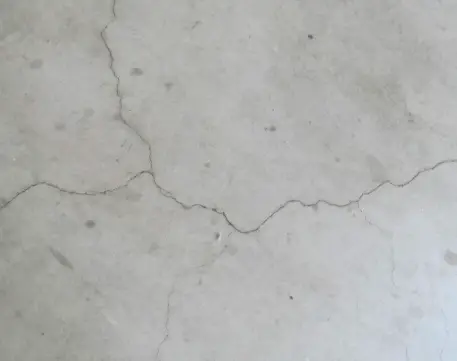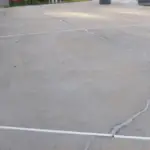Cracks in a concrete makes an area unsightly, difficult to clean and can be a tripping hazard. Cracked concrete patio, driveways or walkways should be repaired to restore their aesthetic value and durability.

In this guide, learn how to fix cracks in concrete, reasons for concrete cracking and how to prevent future cracking of a concrete patio.
Why does Concrete Cracks
While concrete is known to be one of the strongest and durable building material, cracks can form in your old or newly concrete due to the following reasons:
1. Excess water
Excess water in a freshly poured concrete can cause it to crack. Overexposure to water can also make old and dry concrete to weaken and develop hairline cracks . Water is usually added to concrete to make it easier to install.
As the concrete dries, water evaporates. Too much water will cause it to shrink to a higher rate than normal thus forming cracks. Concrete is a porous material that is water absorbent. When exposed, dry concrete will draw in water and start to weaken from inside thus creating cracks.
During installation, use recommended amount of water as per the manufacturer’s instructions. Apply protective sealant on your poured concrete patio to prevent water or moisture absorption.
2. Premature drying
Rapid drying of a wet concrete can lead to cracking. This is common when the site is exposed to intensive sunlight, winds or water is not sprinkled over as required during curing period. Slab curing process takes time under a controlled sunlight, temperature and wetness.
Proper site preparation, quality concrete mix and professional finishing practices will greatly help in preventing cracks in addition to creating an appealing project.
3. Weight and pressure
Overloading a slab creates intense pressure on the ground below. Example is when you have heavy patio furniture, driving a heavy truck along your driveway or accidentally dropping a heavy material on the slab especially after a heavy downpour.
Weight and pressure can also cause settling cracks usually as a result of a void in the ground below the concrete. Example is when a large tree root underground has decomposed or the soil was not compacted well after running a utility pipe. The pressure causes soil to refill any void below it and in the process the slab lacks sufficient base support.
4. Temperature variations
Concrete can expand or contract when temperature changes. Cracks can be recorded during a hot sunny month or during a freezing winter. Heat from a fire pit can damage concrete or cause it to crack or explode.
Expansion joints must be put in place during construction to help in easing the expansion and contraction pressure. Heat resistant mats can be used to prevent a fire pit from damaging a concrete patio.
Proper concentration of concrete should also be used in areas with extreme temperature variations. The subgrade should also be prepared and installed according to soil conditions of a given geographical location.
5. Pressure Washing
There are no doubts that a pressure washer is an incredible machine for blasting through stubborn dirt and grime on exterior home surfaces. However, this can come at a price if you fail to obey pressure washer use instructions.
It is very likely that power washing can damage a concrete surface. Blasting a jet of water on weaker edges or constantly at one point can cause cracks in your concrete. It is important you follow every instruction on how to use a pressure washer when cleaning.
How to Fix Cracks in Concrete

Small holes and cracks in a concrete can be repaired by yourself or a professional. Cracks can exist in varied diameters and depth. The type of patch compound to use will depend on the size of the crack.
Wider cracks are best sealed with a concrete patching compound such as mortar mix while smaller ones with a liquid concrete filler.
In your preparation for fixing a cracked concrete, you will need to have tools like hammer, chisel, wire brush, putty knife or trowel and a protective gear. Proceed to repair the crack in concrete as follows:
- Using a hammer and a chisel, dislodge any loose material from the crack as you undercut the sides of the crack to widen its base. This will make the patch material to bond well with the old concrete.
- Clean the crack first by using a wire brush and follow with a pressure washer or garden horse. This is to remove all the dirt, stains or any contamination that may affect adherence of a patch compound.
- Drive all pooling water from the crack either by a wet/dry vacuum or brush. The crack has to remain relatively wet and not completely dry for perfect patching.
- Mix the patch compound as directed by the manufacturer and get ready to apply.
- Trowel the patch into the crack until it looks tight without air spaces. Fill the compound into the crack and smooth its surface to the level of the surrounding concrete.
- Let the compound to cure as directed by the manufacturer before you paint or seal the area to match the rest of the concrete.
Tiny hairline cracks are usually repaired using liquid fillers, epoxy or latex compounds that are applied using a putty knife or directly from a bottle that comes with applicator tip. Since small cracks may also be deep, it is ideal to create a base using a backer rod before the caulk to improve the stability and durability of the seal.
